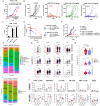Novel PD-1-targeted, activity-optimized IL-15 mutein SOT201 acting in cis provides antitumor activity superior to PD1-IL2v
- PMID: 40250867
- PMCID: PMC12007054
- DOI: 10.1136/jitc-2024-010736
Novel PD-1-targeted, activity-optimized IL-15 mutein SOT201 acting in cis provides antitumor activity superior to PD1-IL2v
Abstract
Background: SOT201 and its murine surrogate mSOT201 are novel cis-acting immunocytokines consisting of a humanized/murinized/, Fc-silenced anti-programmed cell death protein 1 (PD-1) monoclonal antibody (mAb) fused to an attenuated human interleukin (IL)-15 and the IL-15Rα sushi+ domain. Murine mPD1-IL2v is a conjugate of a murinized, Fc silenced anti-PD-1 mAb bearing human IL-2 with abolished IL-2Rα binding. These immunocytokines spatiotemporally reinvigorate PD-1+ CD8+ tumor-infiltrating lymphocytes (TILs) via cis-activation and concomitantly activate the innate immunity via IL-2/15Rβγ signaling.
Methods: Human peripheral blood mononuclear cell and cell lines were used to evaluate cis/trans activity of SOT201. Anti-PD-1 mAb responsive (MC38, CT26) and resistant (B16F10, CT26 STK11 KO) mouse tumor models were used to determine the anticancer efficacy, and the underlying immune cell activity was analyzed via single-cell RNA sequencing and flow cytometry. The expansion of tumor antigen-specific CD8+ T cells by mSOT201 or mPD1-IL2v and memory CD8+ T-cell generation in vivo was determined by flow cytometry.
Results: SOT201 delivers attenuated IL-15 to PD-1+ T cells via cis-presentation, reinvigorates exhausted human T cells and induces higher interferon-γ production than pembrolizumab in vitro. mSOT201 administered as a single dose exhibits strong antitumor efficacy with several complete responses in all tested mouse tumor models. While mPD1-IL2v activates CD8+ T cells with a 50-fold higher potency than mSOT201 in vitro, mSOT201 more effectively reactivates effector exhausted CD8+ T cells (Tex), which demonstrate higher cytotoxicity, lower exhaustion and lower immune checkpoint transcriptional signatures in comparison to mPD1-IL2v in MC38 tumors in vivo. This can be correlated with a higher rate of complete responses in the MC38 tumor model following mSOT201 treatment when compared with mPD1-IL2v. mSOT201 increased the relative number of tumor antigen-specific CD8+ T cells, and unlike mPD1-IL2v stimulated greater expansion of adoptively transferred ovalbumin-primed CD8+ T cells simultaneously limiting the peripheral CD8+ T-cell sink, leading to the development of memory CD8+ T cells in vivo.
Conclusions: SOT201 represents a promising therapeutic candidate that preferentially targets PD-1+ TILs, delivering balanced cytokine activity for reviving CD8+ Tex cells in tumors. SOT201 is currently being evaluated in the Phase I clinical study VICTORIA-01 (NCT06163391) in patients with advanced metastatic cancer.
Keywords: Cytokine; Immune Checkpoint Inhibitor; Immunotherapy; T cell; Tumor microenvironment - TME.
© Author(s) (or their employer(s)) 2025. Re-use permitted under CC BY-NC. No commercial re-use. See rights and permissions. Published by BMJ Group.
Conflict of interest statement
Competing interests: All authors except VM, KB, MS, RM, MR and MK are employees of SOTIO Biotech a.s and DB is the CEO of Cytune Pharma.
Figures





References
MeSH terms
Substances
Associated data
LinkOut - more resources
Full Text Sources
Medical
Research Materials
